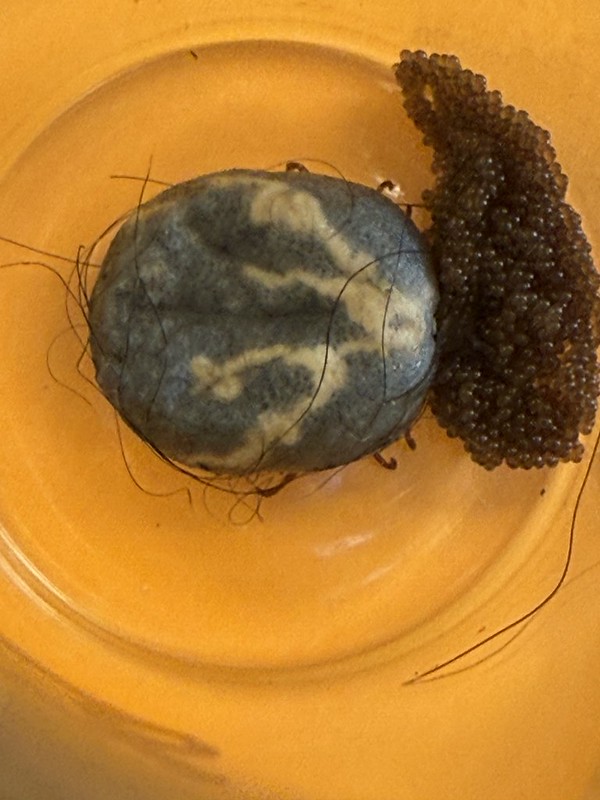Division of Agriculture researchers track Asian longhorned tick, related pathogen in Arkansas
June 9, 2025
By Ryan McGeeney
U of A System Division of Agriculture
Fast Facts:
- Tick confirmed in six Arkansas counties; pathogen in eight
- Symptoms of Theileria similar to anaplasmosis
- Study funded by USDA NIFA grant
(660 words)
(Newsrooms: With photos of Asian longhorned tick; SUBS 7th graf to CORRECT spelling of Loftin's first name)
LITTLE ROCK — Researchers with the University of Arkansas System Division of Agriculture are tracking the spread of an invasive tick affecting cattle in Arkansas.
The Asian longhorned tick (Haemaphysalis longicornis) was first confirmed in the United States in 2017. Ticks collected in New Jersey and West Virginia in 2010, however, were initially identified as rabbit ticks but later identified and confirmed as Asian longhorned ticks. It carries the pathogen Theileria orientalis; two genotypes of the pathogen, Ikeda and Chitose, have been confirmed in Arkansas.
The study to determine the prevalence of both the tick and the pathogen in Arkansas cattle is funded by a U.S. Department of Agriculture National Institute of Food and Agriculture grant (USDA NIFA Award No. 2024-67016-42397).
The Asian longhorned tick has been confirmed in at least 20 states, most of which are in the eastern half of the country, and as far west as eastern Oklahoma.
Mirroring anaplasmosis
Kirsten Midkiff, extension animal health and wellbeing specialist for the Division of Agriculture, said cattle infected with Theileria exhibit symptoms that mirror Anaplasmosis, a bacterial disease many Arkansas cattle producers will likely be more familiar with.
“We’ll see weight loss in those cattle, suppression of milk production, loss of appetite, anemia, and reproductive problems like abortions,” Midkiff said. “You’ll also see some jaundice, weakness or reluctance to move, even death in some cases.”
In early June, Kelly Loftin, extension entomologist for the Division of Agriculture, co-authored an update on the prevalence of both the tick and the pathogen with fellow Division of Agriculture researchers Emily McDermott, Elizabeth Smith and Jeremy Powell. The Asian longhorned tick has been confirmed in Benton, Boone, Independence, Newton, Searcy and Washington counties. The Theileria pathogen has been confirmed in cattle in Arkansas, Baxter, Boone, Carroll, Lonoke, Marion, Searcy and Washington counties.
Loftin said there is no evidence to suggest Theileria poses a health risk to humans.
The tick burden of the reddish-brown Asian longhorned tick can be extremely high, with host animals sometimes carrying hundreds or thousands of the ticks — although no extreme cases have been identified in Arkansas to date. Researchers have found the tick on 44 host species, including mammals and birds.
Other vectors
Midkiff said Theileria can also be transmitted through biting insects, such as biting flies and other ticks, as well as through shared needles. Because Theileria is a bloodborne pathogen, the risk of transmitting chute side while giving routine vaccinations or injections is high.
“If you’ve got a cow that’s tested positive for Theileria, or if you suspect you may have infected livestock, and you’re doing vaccinations, get those needles changed out so that you’re not continuing that spread throughout your herd,” Midkiff said.
Midkiff said that there is currently no treatment for Theileria in cattle, and if producers suspect the Asian longhorned tick or Theileria in their herds to contact a veterinarian. According to USDA, mortality rates typically range from 1 to 5 percent, although they can be as high as 50 percent.
Loftin said that a vaccine targeting five ticks — the lone star tick, Gulf Coast tick, American dog tick, black-legged tick and the Asian longhorned tick — is now available, but only through a veterinarian and approval from the Arkansas State Veterinarian.
“The vaccination regime is an initial immunization followed by the administration of a booster 28 days later,” Loftin said. “This vaccine is designed to elicit production of antibodies that bind to proteins in the tick’s gut. It is hoped that this will prevent the tick from absorbing nutrients. And if fewer nutrients are absorbed, tick engorgement and egg production will be reduced.”
Because efficacy data for this vaccine is not available, Powell, Loftin and McDermott are conducting a study to evaluate the vaccine’s impact on tick attachment, tick engorgement, egg production, egg hatching and tick abundance in the environment.
Recommendations for controlling tick populations in animals more generally through pesticides can be found in the Division of Agriculture publication MP144, “Insecticide Recommendations for Arkansas.”
To learn about extension programs in Arkansas, contact your local Cooperative Extension Service agent or visit www.uaex.uada.edu. Follow us on X and Instagram at @AR_Extension. To learn more about Division of Agriculture research, visit the Arkansas Agricultural Experiment Station website: https://aaes.uada.edu/. Follow on X at @ArkAgResearch. To learn more about the Division of Agriculture, visit https://uada.edu/. Follow us on X at @AgInArk.
About the Division of Agriculture
The University of Arkansas System Division of Agriculture’s mission is to strengthen agriculture, communities, and families by connecting trusted research to the adoption of best practices. Through the Agricultural Experiment Station and the Cooperative Extension Service, the Division of Agriculture conducts research and extension work within the nation’s historic land grant education system.
The Division of Agriculture is one of 20 entities within the University of Arkansas
System. It has offices in all 75 counties in Arkansas and faculty on three campuses.
Pursuant to 7 CFR § 15.3, the University of Arkansas System Division of Agriculture offers all its Extension and Research programs and services (including employment) without regard to race, color, sex, national origin, religion, age, disability, marital or veteran status, genetic information, sexual preference, pregnancy or any other legally protected status, and is an equal opportunity institution.
# # #
Media Contact:
Ryan McGeeney
rmcgeeney@uada.edu
@Ryan_McG44
501-671-2120
